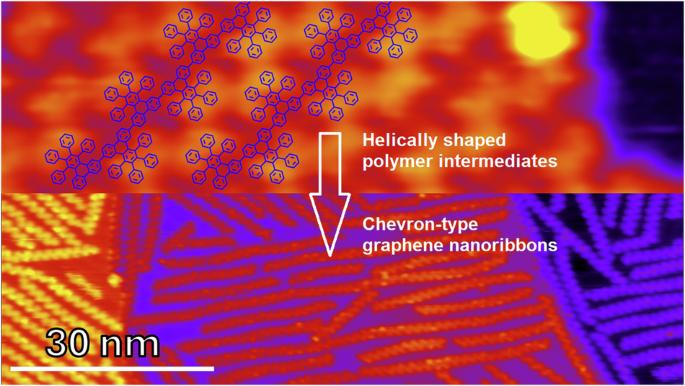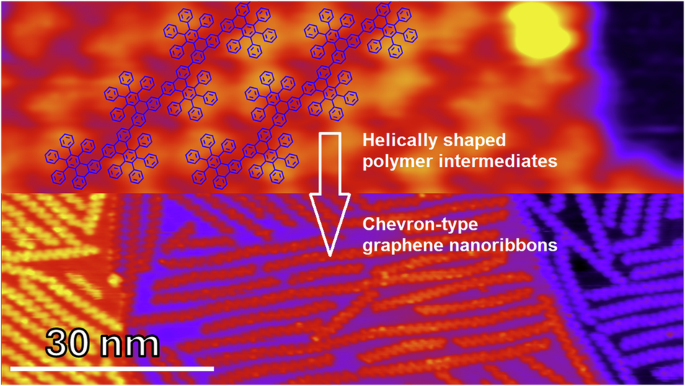沉积温度介导的氟化前驱体螺旋形聚合物和雪佛龙型石墨烯纳米带的生长
IF 5.9
2区 化学
Q1 CHEMISTRY, MULTIDISCIPLINARY
引用次数: 0
摘要
精确尺寸和形状的石墨烯纳米带(GNR)对于控制电子特性和未来设备应用至关重要,可以通过使用合理设计的分子前驱体在表面进行精确合成来实现。含氟前驱体有可能在适合器件制造的非金属基底上形成 GNR。在此,我们结合扫描隧道显微镜、X 射线光电子能谱和密度泛函理论模拟,研究了一种新的含氟前驱体--6,11-二碘-1,4-双(2-氟苯基)-2,3-二苯基三亚苯(C42H24F2I2)在沉积温度介导下在金(111)上生长成螺旋形聚合物中间体和雪弗龙型 GNR 的过程。含氟前驱体在较低温度下不会吸附在金(111)表面,因此需要一个最佳的基底温度来获得最大的聚合物和 GNR 长度。我们将吸附行为与原始雪佛龙前驱体的吸附行为进行了比较,并讨论了 C-H 键和 C-F 键的影响。研究结果阐明了含氟前驱体 GNR 的生长机制,为今后在非金属基底上合成 GNR 奠定了基础。含氟前驱体为石墨烯纳米带的表面合成提供了新的机遇,但要获得最佳结果,生长条件至关重要。在此,作者研究了在金(111)上由内部含氟前驱体沉积温度介导的螺旋形聚合物和石墨烯纳米带的生长。本文章由计算机程序翻译,如有差异,请以英文原文为准。


Deposition temperature-mediated growth of helically shaped polymers and chevron-type graphene nanoribbons from a fluorinated precursor
Graphene nanoribbons (GNRs) of precise size and shape, critical for controlling electronic properties and future device applications, can be realized via precision synthesis on surfaces using rationally designed molecular precursors. Fluorine-bearing precursors have the potential to form GNRs on nonmetallic substrates suitable for device fabrication. Here, we investigate the deposition temperature-mediated growth of a new fluorine-bearing precursor, 6,11-diiodo-1,4-bis(2-fluorophenyl)-2,3-diphenyltriphenylene (C42H24F2I2), into helically shaped polymer intermediates and chevron-type GNRs on Au(111) by combining scanning tunneling microscopy, X-ray photoelectron spectroscopy, and density functional theory simulations. The fluorinated precursors do not adsorb on the Au(111) surface at lower temperatures, necessitating an optimum substrate temperature to achieve maximum polymer and GNR lengths. We compare the adsorption behavior with that of pristine chevron precursors and discuss the effects of C-H and C-F bonds. The results elucidate the growth mechanism of GNRs with fluorine-bearing precursors and establish a foundation for future synthesis of GNRs on nonmetallic substrates. Fluorine-bearing precursors offer new opportunities for the on-surface synthesis of graphene nanoribbons, but the growth conditions are critical for achieving optimal results. Here, the authors investigate the deposition temperature-mediated growth of helically shaped polymers and graphene nanoribbons on Au(111) from an internally fluorinated precursor.
求助全文
通过发布文献求助,成功后即可免费获取论文全文。
去求助
来源期刊

Communications Chemistry
Chemistry-General Chemistry
CiteScore
7.70
自引率
1.70%
发文量
146
审稿时长
13 weeks
期刊介绍:
Communications Chemistry is an open access journal from Nature Research publishing high-quality research, reviews and commentary in all areas of the chemical sciences. Research papers published by the journal represent significant advances bringing new chemical insight to a specialized area of research. We also aim to provide a community forum for issues of importance to all chemists, regardless of sub-discipline.
 求助内容:
求助内容: 应助结果提醒方式:
应助结果提醒方式:


